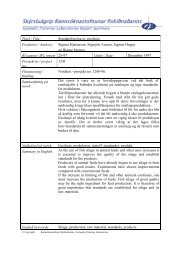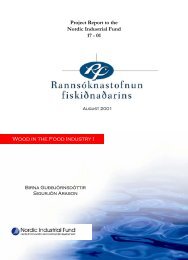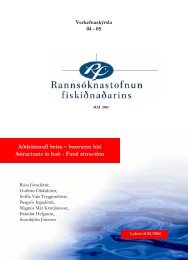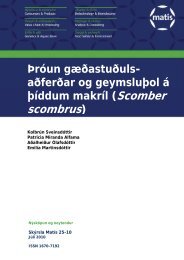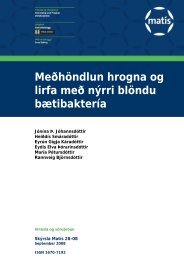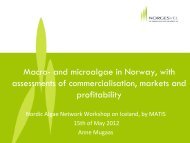Microbiology and Spoilage Trail in Nile Perch (Lates niloticus), Lake ...
Microbiology and Spoilage Trail in Nile Perch (Lates niloticus), Lake ...
Microbiology and Spoilage Trail in Nile Perch (Lates niloticus), Lake ...
Create successful ePaper yourself
Turn your PDF publications into a flip-book with our unique Google optimized e-Paper software.
5.2.2.2 Chemical analysis<br />
The level of Total volatile base nitrogen (TVB-N) <strong>in</strong> chilled <strong>Nile</strong> perch fillets was constant<br />
at 6-7mgN/100g for the first 12 days of storage but <strong>in</strong>creased rapidly after that to a value of<br />
27mgN/100g at the end of storage period of 23 days. This narrow change was also observed<br />
<strong>in</strong> whole <strong>Nile</strong> perch for the first 3 weeks. However the maximum TVB-N reached <strong>in</strong> chilled<br />
<strong>Nile</strong> perch 27mgN/100g was higher than the level on whole <strong>Nile</strong> perch which was<br />
16mgN/100g. Similar levels of TVB-N values of 18-26mgN/100g were reported on<br />
ra<strong>in</strong>bow trout fillets (Chytiri et al., 2004). This difference <strong>in</strong> TVB-N between whole <strong>Nile</strong><br />
perch <strong>and</strong> chilled fillets may be due to low numbers of spoilage bacteria penetration <strong>and</strong><br />
growth <strong>in</strong> the un-exposed flesh of whole <strong>Nile</strong> perch as compared to exposed chilled fillets<br />
(ICMSF, 1986). Rapid <strong>in</strong>crease <strong>in</strong> TVB-N corresponded with high counts (> 8 log10 cfu/g)<br />
of SSO <strong>and</strong> TVC <strong>in</strong> chilled fillets while similar changes corresponded with > 9 log10 cfu/g<br />
of the same counts <strong>in</strong> the sk<strong>in</strong> of whole <strong>Nile</strong> perch. This is <strong>in</strong> agreement with Chytiri et al.,<br />
(2004) results <strong>in</strong> similar study on ra<strong>in</strong>bow trout fillets stored <strong>in</strong> ice. In the present study the<br />
results are much lower than those earlier reported TVB-N of 48-60mgN/100g <strong>in</strong> <strong>Nile</strong> perch<br />
fillets stored at ambient temperature (Karnick <strong>and</strong> Lima dos Santos, 1985) <strong>and</strong> the limit of<br />
acceptability for iced stored cold water fish 30-35mgN/100g (Connell, 1995 <strong>and</strong> Huss,<br />
1988). The changes <strong>in</strong> concentration of TVB-N <strong>in</strong> spoil<strong>in</strong>g fish has been mentioned as<br />
unreliale <strong>in</strong>dicator for fish freshness, (Chytiri, et al., 2004; Dawood et al., 1986; Kyrana et<br />
al., 1997; Castro et al., 2006 <strong>and</strong> Tejada <strong>and</strong> Huidobro, 2002). The change <strong>in</strong> pH on chilled<br />
<strong>Nile</strong> perch fillets was with<strong>in</strong> the neutral pH range 6.4 to 7.0 units dur<strong>in</strong>g the storage of<br />
whole <strong>Nile</strong> perch above.<br />
5.3 PHASE III: MICROBIOLOGY OF WHOLE NILE PERCH SWABS, ON LINE<br />
FILLETS AND SHELF LIFE OF ESTABLISHMENTS CHILLED FILLETS<br />
5.3.1 Phase III - Trial 1: <strong>Microbiology</strong> of whole <strong>Nile</strong> perch swabs <strong>and</strong> onl<strong>in</strong>e fillets<br />
Swabs which were collected <strong>in</strong> three different establishments from whole <strong>Nile</strong> perch stored<br />
for long <strong>and</strong> short times (days) <strong>in</strong> ice (for 10 days - E1, 17 days - E2, <strong>and</strong> 6 days - E3 days)<br />
prior to process<strong>in</strong>g. Counts prior to wash for Enterobacteriaceae <strong>and</strong> TVC were 2-3 log10<br />
cfu/cm 2 <strong>and</strong> 5-6 log10 cfu/cm 2 respectively. Irrespective of the difference <strong>in</strong> storage days <strong>in</strong><br />
63




